Animals
-
Compost Your Gophers
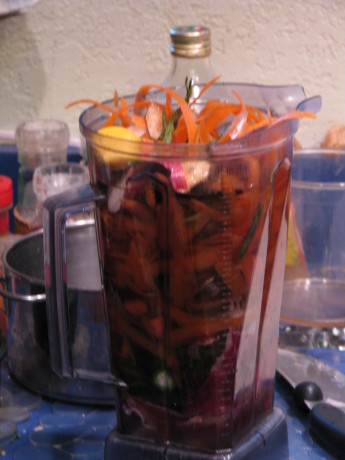
Kitchen scraps blended with a lot of water make excellent liquid compost. I’m a firm advocate of blender composting . Throw your kitchen scraps into your blender (don’t add in items that your blender can’t handle, but throw them in after its blended) with a lot of water and drizzle it around your plants. If its chunky, kick some dirt over it. This feeds your microbes very quickly because the organic matter is bite-sized, and thus feeds your plants. No chemicals necessary.
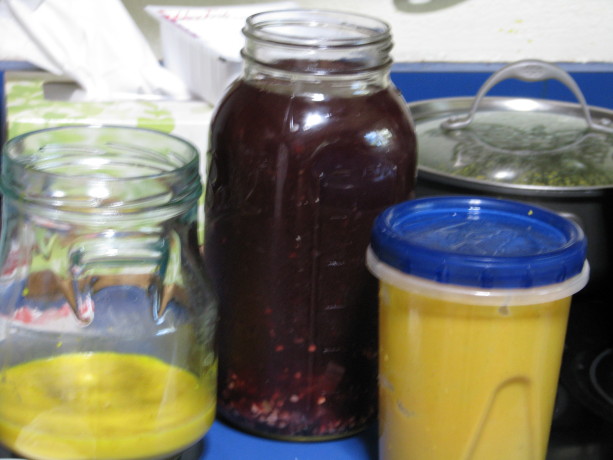
Spoiled soup, pickle juice mixed with old juice… pour it on down the holes! After making pickled jalapenos, salsa, or other spicy foods I thought that the resulting compost smoothie would be very powerful. Indeed it is. So I pour it down gopher holes that are in my garden areas. No one wants jalapeno/onion/garlic water in their livingroom. I’m fertilizing the garden at the same time as discouraging the gophers.
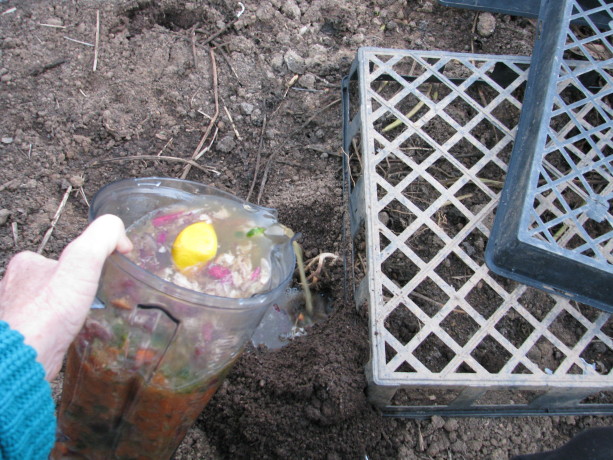
Pouring a noxious brew down a gopher hole. Some solids are just fine, too, as you will be covering it up. Worms just love this. I’ve gone a step farther and made a merry mixup of foods past their prime along with vegetable scraps. Old juice, stinky rice milk, moldy leftovers, the juice from a bottle of pickles, the last of the salsa… whatever you need to throw out, add to your blender liquid and pour it down the holes. It won’t stop the gopher from tunneling in another direction, but it will wreck existing tunnels for them, and feed your worms and microbes. And after watching plants disappear into the ground, pouring evil brews down the hole is very, very satisfying.
- Animals, Gardening adventures, Hugelkultur, Natives, Permaculture and Edible Forest Gardening Adventures, Ponds, Water Saving
Snow at Finch Frolic
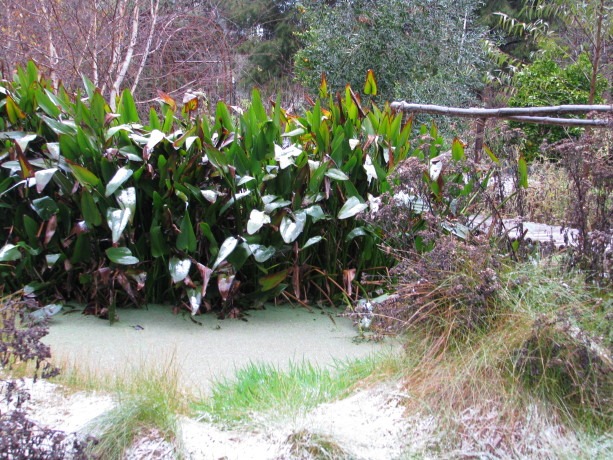
Pickerel and snowy azola on the little pond. Finch Frolic Garden is located in Fallbrook,CA, in sunny San Diego’s North County. Dry and hot conditions are the norm, with temperatures rising above 100 in the summer,and an occasional frost in the winter.
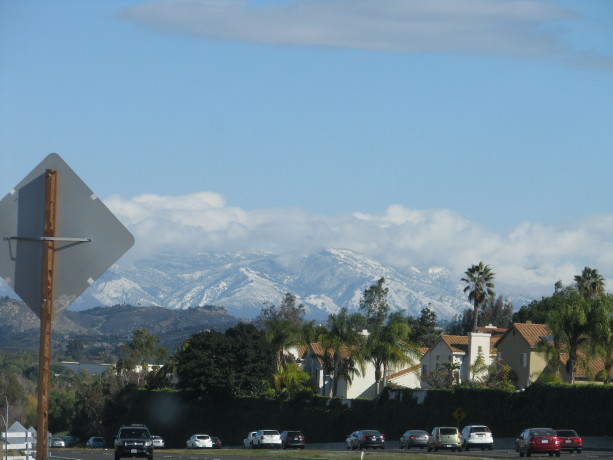
This is a prime Southern California winter scene: palm trees and red tile roofs – and traffic – with snow on the mountains. The peaks are usually only dusted in snow in Jan. or Feb. A rain around Thanksgiving means lawnmowers are humming around New Years. This past year, 2014, has experienced strange weather as has the rest of the world. We had back-to back Santa Anas (hot, dry, high winds from off the desert) in May, which caused many trees and plants to drop flowers. The lack of food and water induced many animals to not reproduce, which affected the rest of the food chain. Then we had fire season in May as well. Unfortunately arson was the cause of some of the fires, but many homes were lost as well as hundreds of acres of our precious endangered chaparral and the baby animals that lived there.
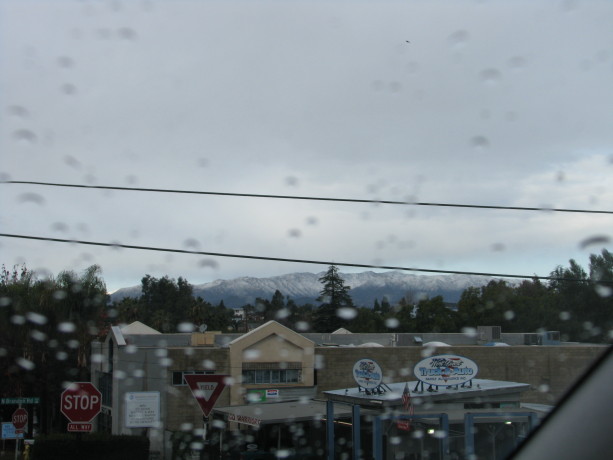
These mountains are northwest of us – they never get snow! Our heat wave came in June, and our ‘June gloom’ – a marine cloud cover – came in July. We had several significant rain events in late Fall, and then on New Year’s eve, it snowed.
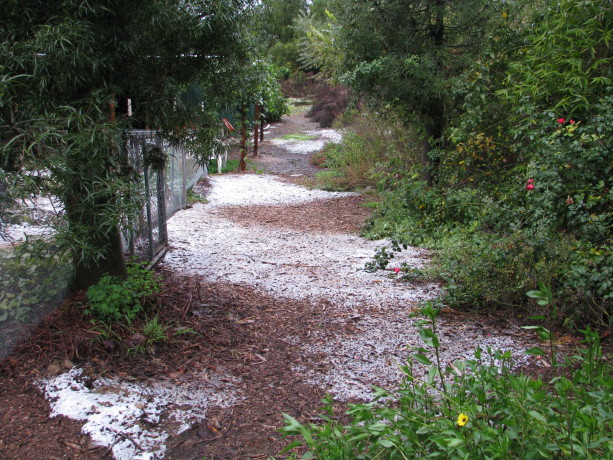
The pathway down to the Mock Pavilion. So many of you who live in snowy areas are saying, “Who cares?” The last snowfall in our inland valley area was in the late 60’s when I was probably 8 or 9 years old. I lived with my sister and parents in Carlsbad, a town west of here. All I remember about it is that my dad made a snowball and froze it, and in the summer threw it at the neighbor.
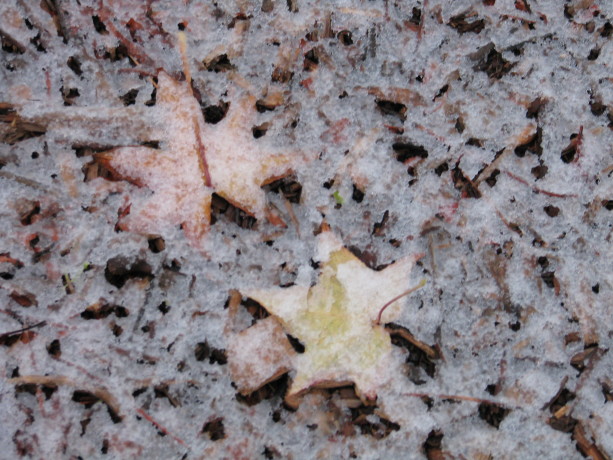
On the 30th we received an inch and a quarter of cold, Canadian rain overnight. The rain came in heavy showers and swales we’d created had filled and prevented flooding. In the morning I looked out on a white garden.

Kitchen garden in snow. Not everyone in the area received snow this week, but streets were icy, nearby Temecula was covered as were all the mountains even those west of here.
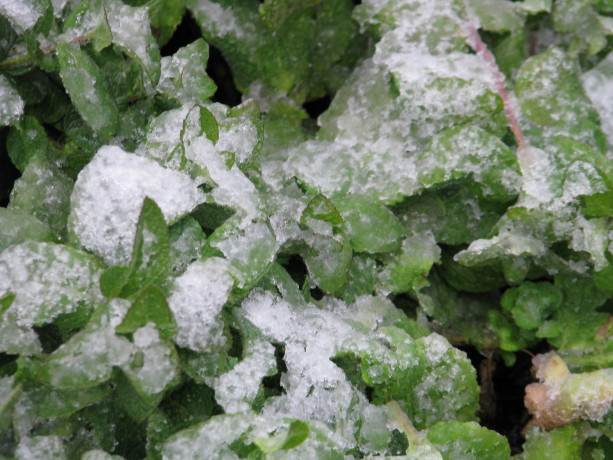
Good-bye ’till next year, apple mint! The landscape looked like a large powdered sugar shaker had been at work overnight.
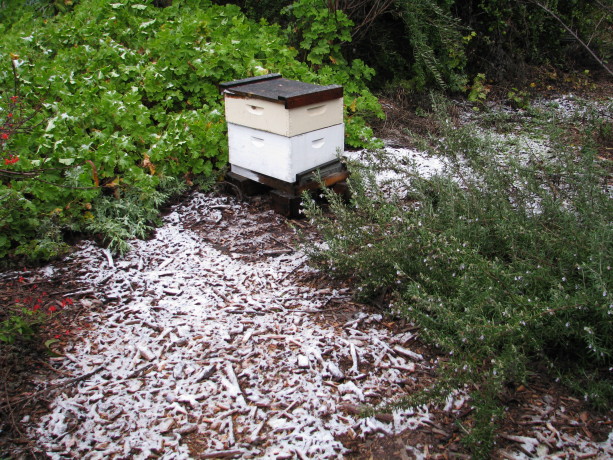
Perhaps this year we can have bees again. Last year they all died – someone spraying in the neighborhood is my guess. Again about 10:30 in the morning snowflakes fell and strangers grinned at each other in delight.
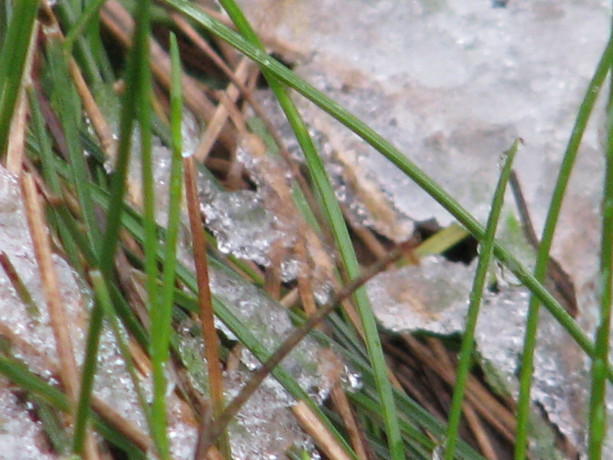
Creeping red fescue, which is an excellent soil holder and groundcover here, just laughed at the cold. Not so the growers of frost-intolerant plants such as avocados, citrus, succulents and tropicals. After the snow we have had clear, frosty nights which have done more damage than the snow had.
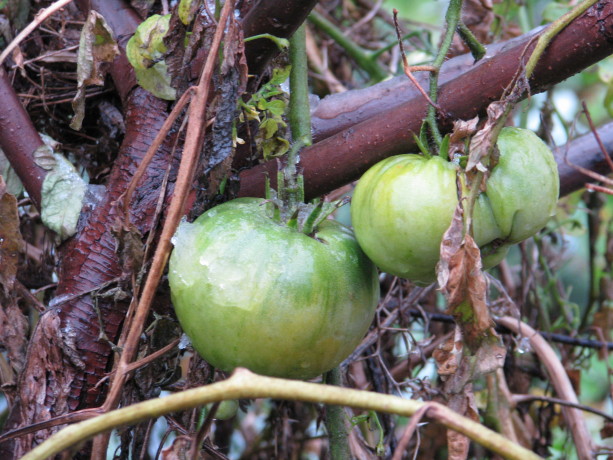
These are now ripening in the house. I don’t expect overwintering tomatoes this year, and we’ve been harvesting the last of our zucchino rampicante, eggplant, jalapenos and tomatoes, and marking where the sweet potatoes lie underground.
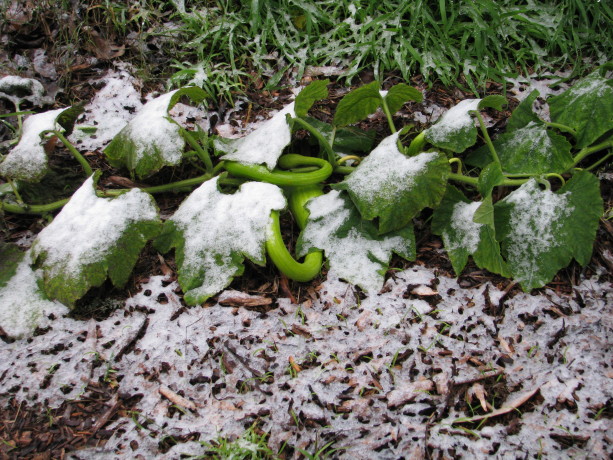
Poor little frosty zucchinos. Our hens aren’t happy about the weather change. We hung towels and tacked up cardboard in their coop for insulation, although now it looks like a cheap harem. Today I bought a heat lamp to keep them warmer.
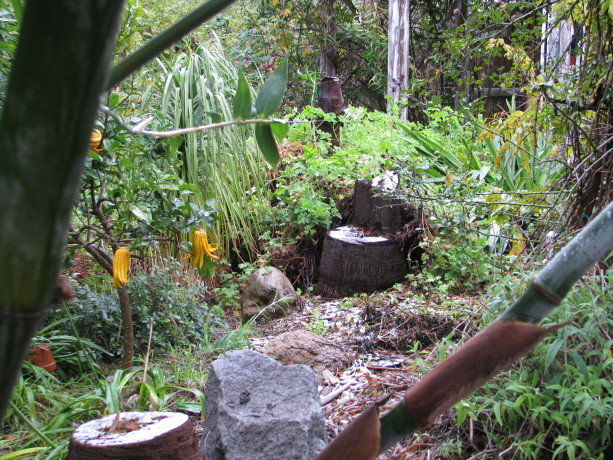
Buddha’s Finger citron and snow. I candied the citron this year and used it in holiday bread. Wonderful! Most of them are done molting except, of course, the Turken or naked-neck. Besides having a naturally bare neck, poor Malika has dropped over half of her feathers and has no insulation at all. Its a good thing that days aren’t frozen, too.
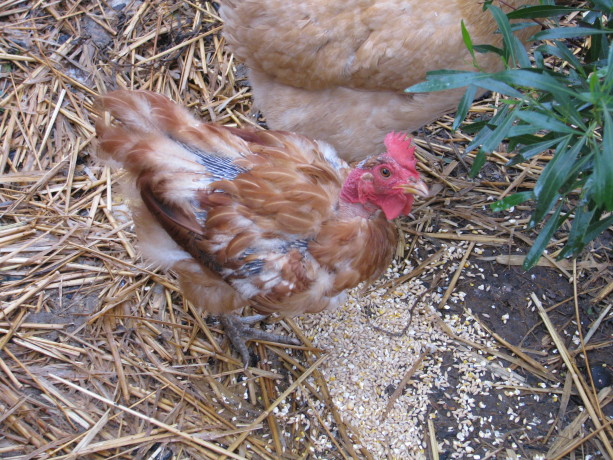
Poor Malika! An unfortunate molt. By Monday daytime temperatures will be in the low 70’s again, and I’ll be worrying about planting spring crops already; despite the snow, there really isn’t a winter here.
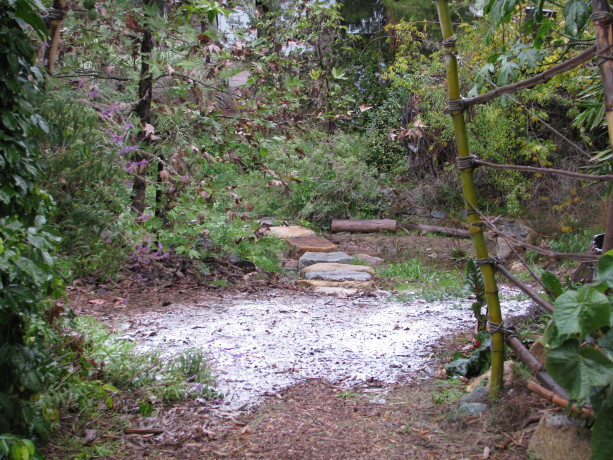 However, I thought I’d share some New Year’s eve photos of Finch Frolic Garden in the snow – not something I’d ever thought I’d see.
However, I thought I’d share some New Year’s eve photos of Finch Frolic Garden in the snow – not something I’d ever thought I’d see.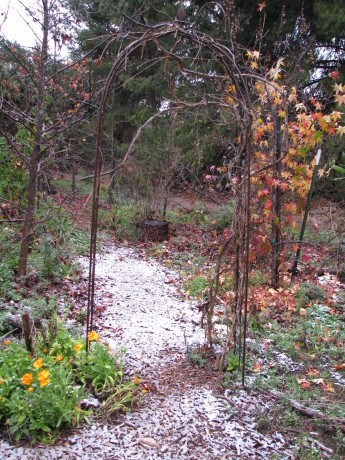
Lovely. Liquidambers, trellis and wildflowers. - Building and Landscaping, Compost, Fungus and Mushrooms, Gardening adventures, Hugelkultur, Microbes and Fungi, Permaculture and Edible Forest Gardening Adventures, Ponds, Rain Catching, Soil, Water Saving
Taming the Rain

Rain compacts bare soil, and in this case making clay soil slick. No percolation is happening here! World-wide we have a fresh water shortage, and the seas are rising. Erosion is cutting into our fields and washing our precious topsoil into waterways, causing them to silt up and die. In some areas of the US, unprecedented flooding from rain is occurring, while out West drought is drying up wells. The reasons for these happenings have to do with our farming techniques to begin with. How to fix the problems all boils down to some very simple methods that everyone can do – that everyone needs to do. It all comes down to making level-bottomed swales, and rain-catchment basins, to make the water penetrate the soil rather than roll over it. Rain compacts soil more than a tractor does – when it falls on bare ground. We have been trained to rake up leaves and burn them or send them to the dump. Leaves, dead vines and other organic matter cushions the rain and keeps the soil from being compacted. That organic matter also feeds the soil microorganisms that make soil hold manage rainwater. With the lack of organic matter, and the use of herbicides to kill off all vegetation, and the proliferation of huge swaths of lawn that is treated routinely with chemicals and therefore make the ground hard, rain rolls across the landscape taking topsoil with it.
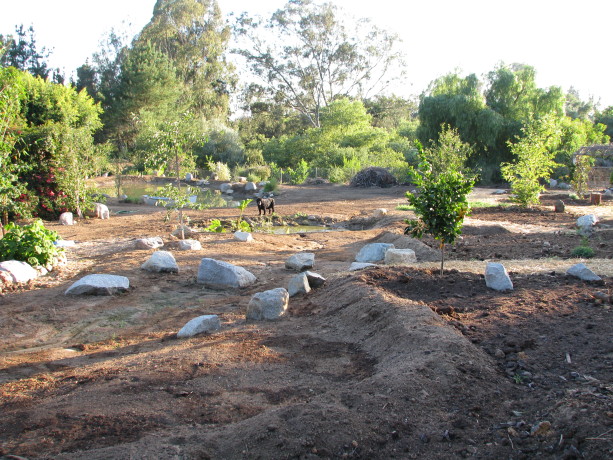
Raised mounds on the downside of swales keep rainwater by plant roots. Many neighborhoods have large culverts through their properties – mine included – where runoff from properties above is purposely channeled through and away from homes. All that precious water is wasted. The same happens in areas where rain is abundant. Rainwater is directed away from properties and into storm drains that fill and overflow, or it puddles in low spots because it has nowhere to go.
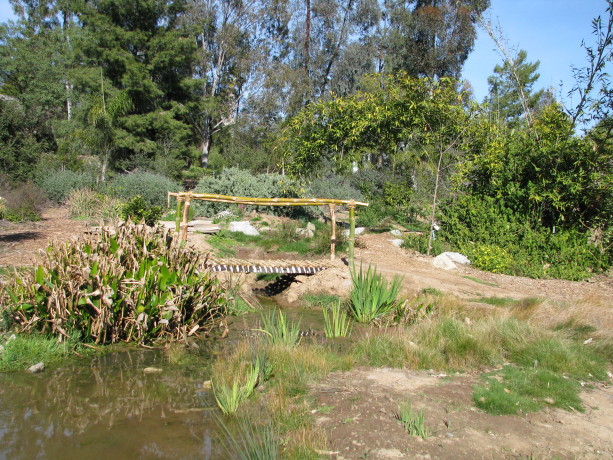
A rainwater and silt basin at the end of a series of rain catchment basins, has turned into a permanent pond. By creating regular level-bottomed swales perpendicular to the flow of water, beginning as high up the landscape as possible, rain will be caught before its momentum running downhill becomes destructive. The water in the swales percolate into the landscape, reestablishing water tables and re-energizing wells and streambeds. Swales should be level at the bottom, dug on contour if large, and have a dedicated overflow into another swale, rain catchment basin or dam. Small property? Dig a small fishscale-shaped swale with a trowel above each of your small trees and plants, perpendicular to the flow of water. Filling these small swales with coarse mulch such as woodchips will keep them moist and weed-free.

With 97% of California wetlands gone, animals have no place to drink. Help them! If your property is the recipient of water from uphill, then talk to all your neighbors above you and convince them to dig swales as well (neighborhood swale-digging party??). The amount of water raging down the hill will become insignificant, and everyone’s trees and plants will flourish due to the water being caught in the soil. The plume of water slowly moving through the landscape encourages tree and plant roots to grow deeper. The roots break through hardpan, produce sugars and proteins and carbohydrates to attract microbes, and create good soil for you.
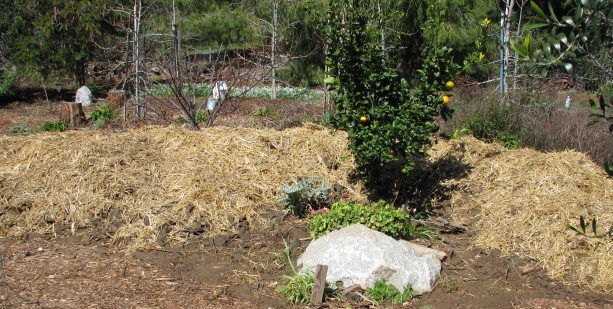
A hugelkultur bed is made from layering wood with dirt and organic materials. It will absorb rainwater and release it slowly as the ground around it dries, while improving the soil. So dig swales and rain catchment basins to passify and hold rainwater. Leave your leaves to prevent compaction and to feed your soil microbes. Enjoy having healthier plants, soil and waterways while helping to put the brakes on global warming.
- Animals, Bees, Birding, Building and Landscaping, Chickens, Compost, Fungus and Mushrooms, Gardening adventures, Hugelkultur, Microbes and Fungi, Natives, Natural cleaners, Other Insects, Permaculture and Edible Forest Gardening Adventures, Pets, Ponds, Predators, Quail, Rain Catching, Reptiles and Amphibians, Water Saving, Worms
Saving the Bees

The ponds at Finch Frolic Garden are cleaned by fish and plants, with no chemicals, algaecide, artificial aeration or filtration. Well-balanced water allows wildlife to thrive. I should have more accurately called this post, Saving All the Insects, or even Saving the Wildlife, because the answer to saving one is the answer to saving them all. We’ve been inundated for years – my whole lifetime, in fact, – with pleas to save our environment, stop whale slaughter, stop polluting, etc. I remember winning a poster contest in fifth grade on the subject of curtailing littering. Since Rachel Carson’s books woke people up to the hazards of DDT and how chemicals have many deadly side effects there has been a grassroots effort to stop the pollution. Since Al Gore’s An Inconvenient Truth came out the push for environmentally friendly lights, cars, LEED-certified buildings and many more positive anti-climate-change actions have grown furiously. Too bad no one listened to him decades before. A drop in the economy and the radical change in weather patterns have people exploring organics, making their own clothes and foods, changing their shopping habits and thinking about what they are bringing into their homes. However, this week the World Wildlife Fund released the staggering results of a study that states that between the years 1970 and 2010, 52% of the world’s animal populations are gone. Over half. Gone. On our watch. In my lifetime. I am stunned with shame. So what about the next 40 years? Over 97% of California wetlands are already gone. There are only 3% left in Los Angeles. The Colorado River hasn’t met the ocean for decades, except briefly last year due to major earthworks. We are pumping all that water overland, open to the sun for evaporation, to treatment plants that fill it with chlorine and other chemicals, then sell it to us to spray over lawns and flush down the toilet or let run down the drain while the water heats up. It is madness. All the wildlife that depended upon the Colorado River along that stretch are gone. All the insects, the frogs, lizards, birds, mammals, etc. that need a clean drink of water no longer have access to it. The only water they can drink is usually chlorinated domestic water in ponds and bird baths. Too often this water is treated with algaecide, which claims it doesn’t hurt frogs but it does kill what the frogs feed upon. We are killing our animals with poisoned domestic water.
![dry_colorado_new[1]](http://www.vegetariat.com/wp-content/uploads/2014/10/dry_colorado_new1-613x321.jpg)
One of the largest reasons we have extinctions in North America is mismanagement of rainwater in drylands (other than polluting the waters. Poaching, over-fishing, destruction of habitat and climate change are the main reasons). We have cleared and flattened the ground, and channel rainwater off into the ocean. Look around at your streets and houses. Are they harvesting water or channeling it? Any property that is slanted is channeling water away. Any property that is level – like the bottom of swales – is harvesting water. So many properties are inundated with annual rains because there is no water harvesting above them. When you harvest water, it runs into rain catchment basins and swales instead of roaring down the hillside taking all the topsoil with it. Water becomes passive and percolates down deeply into the soil. That deep saturation draws tree roots down into the ground. The roots break up hardpan, make oxygen and nutrient channels into the dirt and produce exudates (sugars, carbohydrates and starches) through their roots to attract and feed the billions of microbes that turn your dirt into rain-holding soil. That underground plume of rainwater then slowly passes through your soil, re-enervating subterranean waterways, refilling your wells and bringing long-dry streambeds back to life. We must harvest rainwater to save our animals and plants, and consequently ourselves. We must reestablish sources of clean, unpolluted chemical-free water for animals to eat and from which to drink.
Healthy pond water is off-color due to tannins, and is filled with tiny creatures. Some such as daphnia are visible, but just like soil microbes, many aquatic creatures are microscopic. Fish and frogs feast from this level of the food chain, and these creatures make the water balanced. They eat mosquito eggs. They clean up algae. They are as vitally important as soil microbes. Oh, and 83% of the frogs are gone.
I spoke with Quentin Alexander from HiveSavers today; he performs humane bee rescue around the San Diego area and has been trying to re-queen Africanized hives with calmer European queens which will breed nicer behavior back into the bees rather than having to kill the entire hive. He has had no luck in the past two years with European queens, even those bred in California. With very little wetlands left, and those often sprayed with DEET by Vector Control, or polluted with chemical fertilizers and oils washed out of front yards, streets and driveways, these insects must resort to drinking from swimming pools and bird baths. Again, these contain highly chlorinated water. Animals are being forced to drink poison, or not drink at all.
We MUST stop using chemicals on our properties, and we MUST harvest rainwater. We MUST stop spraying well water into the air but irrigate with it in dripper form under mulch so that it is cycled back into the ground rather than evaporated. One inch of rain on one acre in one hour is 27,154 gallons of water! It is so easy to harvest rainwater – dig level-bottomed swales! Dig small ones with a trowel. Fire up the tractor and turn road ways into swales, or cross-cut vertical paths with swales that have dedicated overflows. Dig rain catchment basins to catch a flow of water. Catch water as high up on your property as you can. If you have level soil, fantastic! You have it so easy!
Make gentle swales, rain gardens, rain catchment areas and sunken gardens to catch and percolate the water. Bury old wood perpendicular to water flow – its called hugelkultur.
Please watch this six-minute video by Geoff Lawton of the Permaculture Design Institute of Australia. You need to type in your name and email, but they don’t sell your information nor do they bug you with lots of emails. Here is the link. The title is Finding An Oasis in the American Desert, and it is about the Roosevelt swales dug during the dust bowl in the desert. If nothing that I say, nor anyone else says can convince you, then please watch this and see the effectiveness of rain harvesting. We MUST do this, and now before the rains come is the time. Catch all the water that falls on your property in the soil, and try to catch the water that runs into it. If there are flood waters channeled through your property, see if you can talk to the people who own land above you about harvesting water up there. It will reduce the flooding, save topsoil and benefit everyone’s property. Work towards keeping rainwater in your soil, reducing your domestic water, and making what streambeds are left come back to life. Keep our old trees from dying by watering deeply through rain catchment. If you have a pond or swimming pool and treat it with harsh chemicals and algaecides, seek out a natural pond professional. In the San Diego – Los Angeles region there is Bob Lloyd of PuraVida Aquatics, or Jacob Hatch of Hatch Aquatics. Jacob builds natural ponds and maintains large natural waterways. Bob maintains chemical-free backyard and display ponds that are full of wildlife. He can convert your pool into a clean swimming pond where the water is filtered by plants and thus is lovely year-round, provides abundant habitat and doesn’t need chemical treatments. No chlorine to burn your skin and eyes. How great is that? He can also create a constructed wetland that cleans your greywater with plants.
There are so many simple and inexpensive ways to harvest rainwater rather than allow it to flow into the salty ocean without penetrating the soil. Please, please, please do them, and if you already have THANK YOU and gently encourage your neighbors to do the same. We must stop the habitat destruction and start to rebuild what is gone.
- Animals, Health, Hugelkultur, Microbes and Fungi, Other Insects, Permaculture and Edible Forest Gardening Adventures, Ponds, Soil, Water Saving, Worms
Microbiology For The Layman
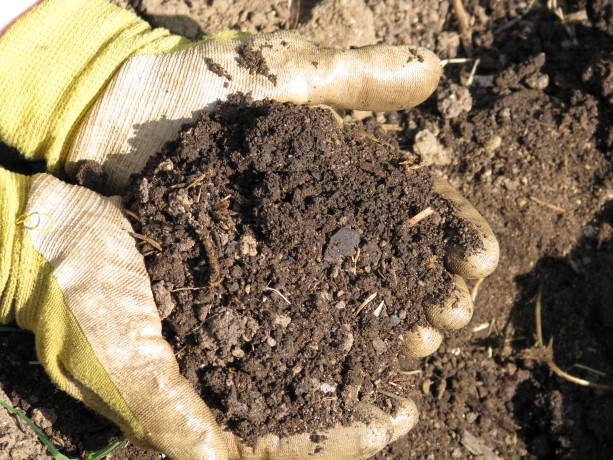 A Permaculturalist’s Explanation of How Life Works
A Permaculturalist’s Explanation of How Life WorksWant to understand the microbial life in compost, in ponds and in our bodies? This lecture by microbiologist Dr. Robert Lloyd will provide you with a basic understanding of how microbes work and what they do. Fascinating and comprehensible for the layman, this talk is essential for those who want to understand more about how life works, in or out of the garden and pond.
This lecture will take place on Saturday, October 11,
4 PM – 6 PM, at beautiful Finch Frolic Garden in Fallbrook. Light homemade refreshments will be served. The fee for the lecture is $20. Please RSVP to dianeckennedy@prodigy.net. The fee can be sent to Finch Frolic Garden, 390 Vista del Indio, Fallbrook, CA 92028 (also the location of the talk).
Dr. Robert Lloyd is owner of PuraVida Aquatic.He has maintained chemical-free ponds and aquariums for 20 years. He also can convert chlorinated swimming pools to chemical-free, naturally balanced, swimmable and healthy ecosystems. (www.puravidaaquatic.com)
Please bring soil, water, or any sample you would like to examine under a microscope!
- Animals, Chickens, Compost, Gardening adventures, Hugelkultur, Other Insects, Permaculture and Edible Forest Gardening Adventures, Seeds, Soil, Vegetables, Water Saving, Worms
Using Smuck, or Using Food Waste
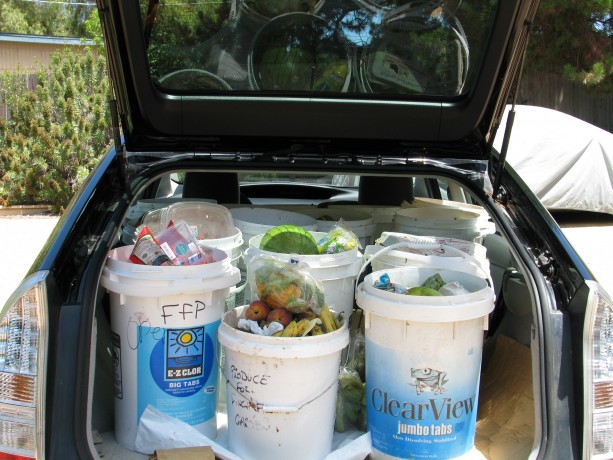
One afternoon’s haul of smuck. Just when I was mourning the fact that our household didn’t create enough food waste to generate lots of compost, I received an email from a former visitor to Finch Frolic Garden. She volunteers at the Fallbrook Food Pantry, where they distribute balanced food supplements to over 800 families a week who earn less than the US poverty limit. They receive raw, outdated fruit and vegetables from grocery stores and other sources, sort through it and have to discard what isn’t safe to hand out. The volunteer knew that I composted and wondered if I’d like to pick up the residue so that they wouldn’t have to throw it out. She and the director had been taking it home, but it was too much for them. Four times a week I’ve been picking up buckets of smuck, or what I call the rotting fruit and vegetables, and often its too much for me as well.
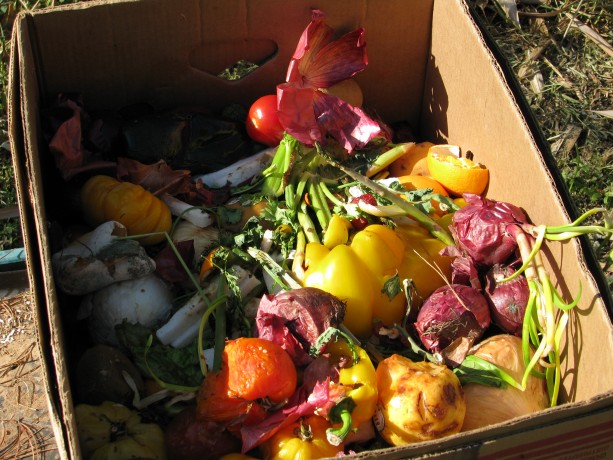
Boxes of mixed smuck were difficult to pick up and very, very juicy. Buckets are better. There has been a grace period where my daughter and I nearly broke our backs picking up cardboard boxes sodden with fruit juice that stained our clothes and our car, and spent lots of time cutting produce out of plastic bags and containers, but the Food Pantry staff have been wonderful about usually opening the packages and using only old pool buckets.
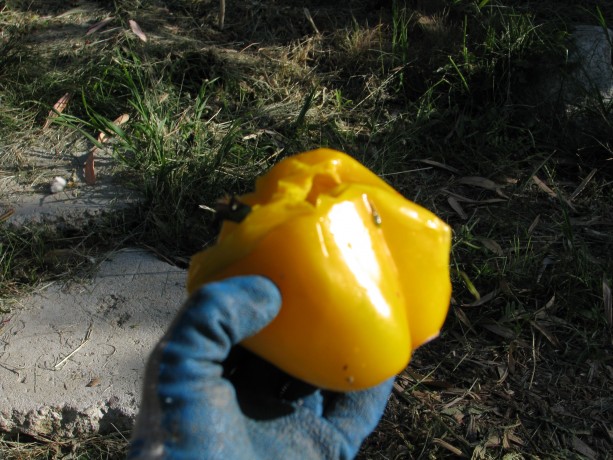
One drawback is that very little of the smuck is organic. We are constantly amazed at how fruit and vegetables remain hard on the outside while rot on the inside. These peppers were hybridized to be solid enough to ship without bruising, at the expense of flavor and nutrition. My back, my clothes and my car thank them. Fortunately others have been picking some smuck up. The man in my life happily takes lots of it to feed to his compost worms. We’re a great match.
My daughter and I empty the buckets into the chicken coop.
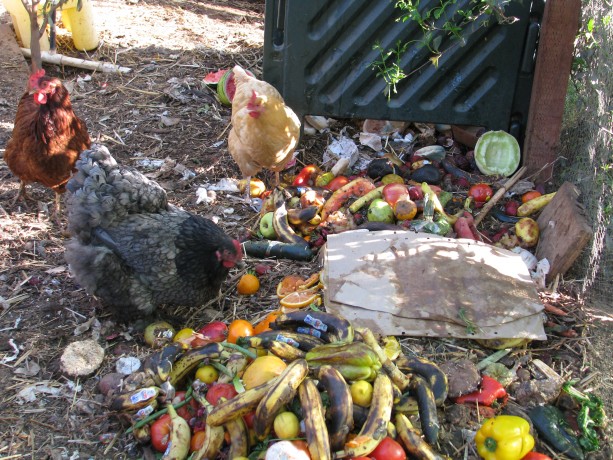
Charlotte, Bodicea and Esther/Myrtle with a new batch of smuck, heavy on the bananas. The girls love it. I make sure they eat lay crumble and calcium as well to keep laying, but with the smuck they’ve reduced their intake of crumble and hence have lowered my expense.
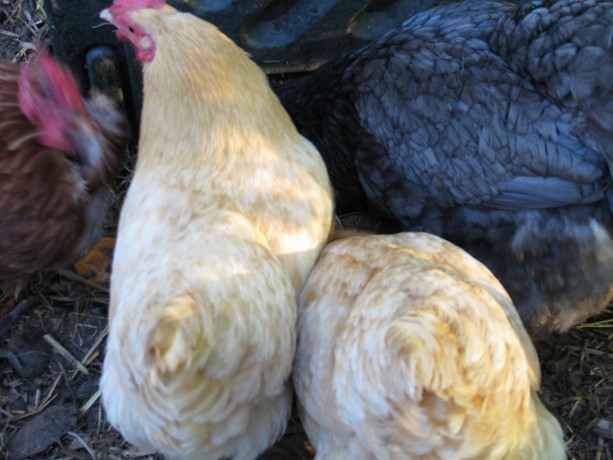
The girls going after the smuck. I pitchfork straw and weeds over the top and within a few days most of it except some citrus and a coconut or two is pretty much gone. There is a fly problem, but with the flies there have come more flycatchers and lizards, and the hens eat the insect larvae that emerges in the compost.
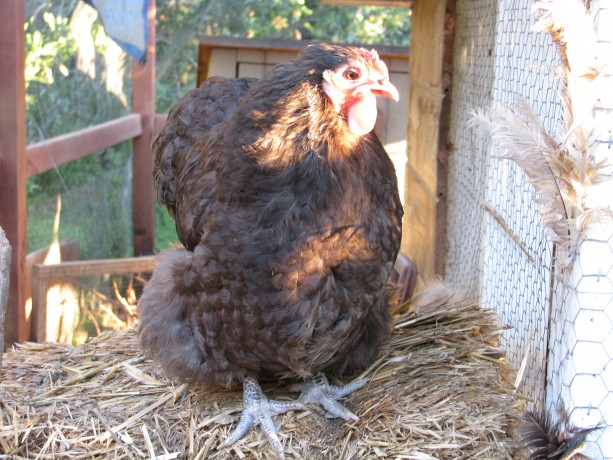
This is Agatha, named after a favorite mystery writer. She’s here just because she’s so lovely. The picking up of smuck, hauling it down the hill and into the coop, de-packaging, cleaning buckets and fighting flies and ants, three – to -four times a week has been a time-consuming and very, very icky job, but the thought of all that free waste going into the dumpster keeps me at it. This is bacteria-heavy compost material, which is excellent for growing non-woody herbaceous plants such as our own vegetables and herbs.
I’ve also layered the smuck with cardboard, paper waste from the house (tissues, paper towels, cotton balls, Q-tips, junk mail, shredded paper, etc.) under the bananas.
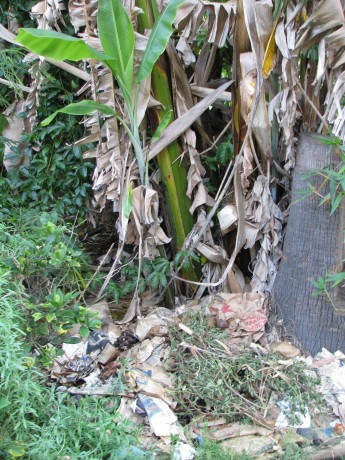
A pile of fruit, veggies and cardboard, partially covered with clippings, at the food of our big banana. A citrus to the side likes it, too. Bananas love lots of food in the form of moist compost around their roots; in fact, they are commonly planted in banana circles with understory plants and the center of the circle is a place for waste products to deteriorate. In our dry San Diego climate we don’t have that kind of tropical moisture to help it rot, but the compost does become a sheet mulch and really helps create soil.
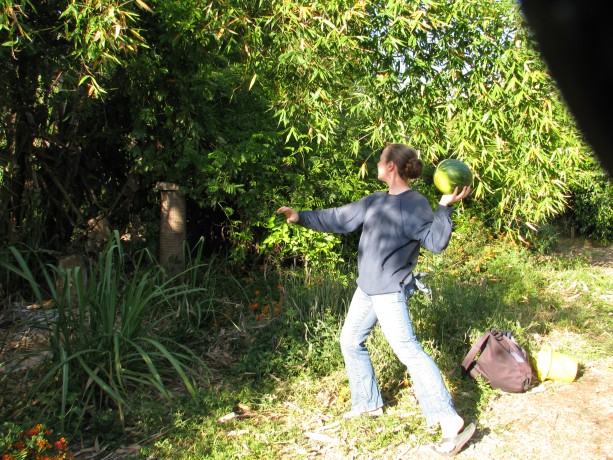
Miranda adds a melon to the banana circle smuck. One inch of compost reduces watering needs by ten percent, so a pile of wet smuck layered with carbon items such as dry cuttings and cardboard is excellent. I throw cuttings and pine needles over the top to keep down the rotty fruit smell, which doesn’t last long anyway.
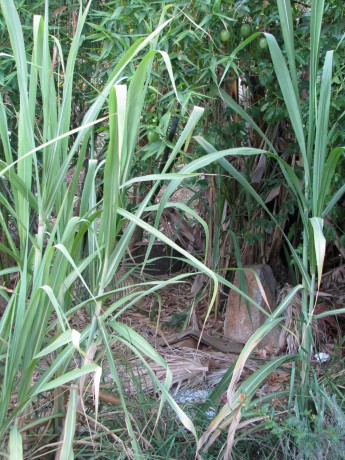
Sugar cane and passionfruit enjoy the smuck layers under the banana – kind of a banana semi-circle. When creating new impromptu trellises for melons and squash in unimproved soil, Miranda and I dug trenches, threw in wet wood and dumped buckets of smuck right on top then covered the trench with dirt. We planted seeds in handfuls of good compost and away they went. We also used some of the mostly composted soil from the Fowl Fortress directly into the kitchen garden .

We augmented the kitchen garden soil with nearly-composted smuck dirt. Due to the wide variety of fruit and vegetables in the smuck buckets we’ve had some interesting volunteer plants. Tiny tear-shaped tomatoes that had been sold in plastic containers for natural snacks, a sweet potato, other tomatoes, and melons. At least we thought they were melons.
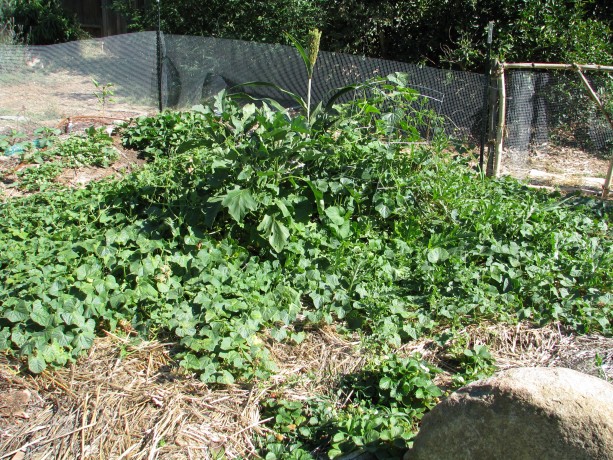
Melon vines taking over the kitchen garden… but not the melons we expected! Miranda was wondering about pulling them out of the kitchen garden because they were taking over without apparently producing a flower. A couple of days ago she investigated further and found a real surprise. We have about thirty kiwanos growing under the foliage!
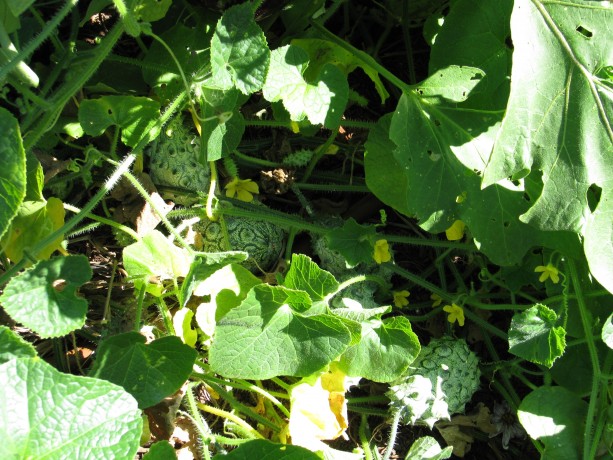
Kiwanos with lots of blooms lurking beneath the foliage. I’ve never eaten a kiwano. Wikipedia says: Cucumis metuliferus, horned melon or kiwano, also African horned cucumber or melon, jelly melon, hedged gourd, melano, in the southeastern United States, blowfish fruit, is an annual vine in the cucumber and melon family, Cucurbitaceae. I’ve seen them in the smuck buckets, and it just figures that of all the green melons and orange melons that we’ve thrown in there, something like these would grow! None have ripened to the light orange color as yet, which is good because it gives us time to figure out what to do with them.
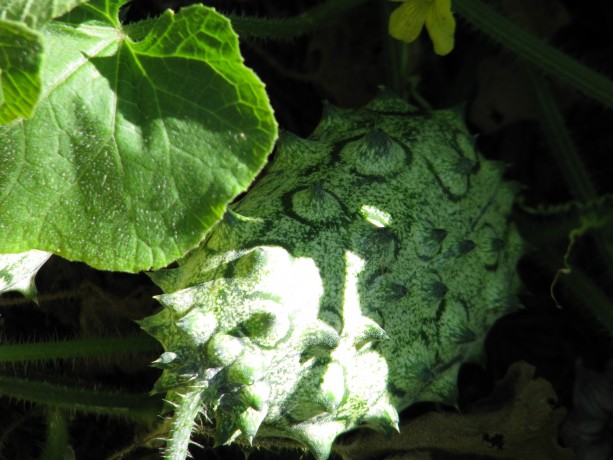
When they turn orange they’ll really look like blowfish fruit! - Animals, Bees, Birding, Gardening adventures, Natives, Other Insects, Permaculture and Edible Forest Gardening Adventures, Ponds, Rain Catching, Soil
Summer At Finch Frolic Garden
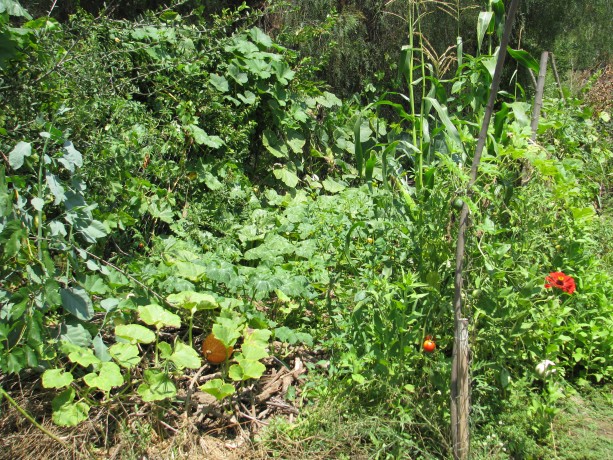
Squash, melons, tomatoes, flowers, tomatillos, sweet potatoes and more flourish along a chain link fence and on a wire-and-post trellis we set up over buried wood. Vertical space is perfect for vines; the vines provide shade and protection for other plants, and mulch plus a harvest when they die down. They are exciting and fun to watch grow as well. I’ve wanted to show you more of the garden, using video as well as photos. The summer garden is beautiful and full of life. Life in the ground, in the water, in the air and on every plant. Last year the pond had an overgrowth of pond weed and algae. Since our pond is natural – meaning that it has no liner, just compressed clay, and is cleaned only by plants and fish with no other aeration or filtration – the idea of adding algaecide is unthinkable. In great pond water there are as many if not more microbes as in good soil. Algaecide may advertise that it doesn’t harm fish or frogs, but it will kill the small pond life that is keeping your pond and its animals healthy. Seven small koi were added (rescued from a golf course pond where they had been dumped) in the hopes that they would eat the emergent pond weed as it grew out of dormancy. We hadn’t seen the koi and thought that they were dead. A couple of months ago they were sighted: all seven, each about a foot long and magnificent. We have no pond weed nor algae overgrowth thanks to these beauties.
In the following short video you’ll see some of the koi and possibly some of the bluegill and mosquito fish that also inhabit the pond. Notice a small blue dragonfly alighting on the bamboo pole. Birds call out all around. You’ll also hear my work shoes squeaking! The size and vigor of the water lilies is due to the healthy, microbially balanced water. We keep the pond topped up from the well. Well water here in San Diego County is notoriously salty and mineral-laden. Plants and microbes remediate that water, as is obvious in this video. The last part is of the native marsh fleabane which was sown by wild birds and flourishes around the pond. The small groups of flowers are perfect for our tiny native insects to land upon and feed. A honeybee uses it here. Enjoy with me a moment by the pond; the following link will send you to a Youtube video:
- Animals, Bees, Birding, Building and Landscaping, Chickens, Cob, Compost, Composting toilet, Fungus and Mushrooms, Gardening adventures, Giving, Health, Heirloom Plants, Hiking, Houses, Hugelkultur, Humor, Living structures, Natives, Natural cleaners, Other Insects, Permaculture and Edible Forest Gardening Adventures, Pets, Photos, Predators, Quail, Rain Catching, Recycling and Repurposing, Reptiles and Amphibians, Seeds, Soil, Vegetables, Water Saving, Worms
Special Tours for Aug. and Sept., 2014
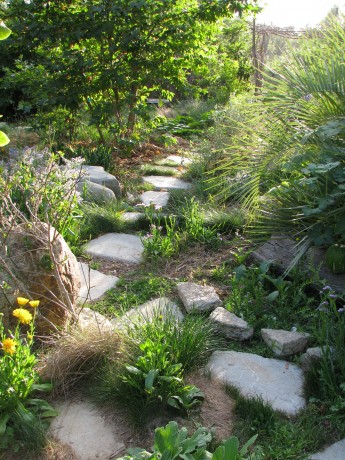
Come take a tour of a food forest! Normally tours of Finch Frolic Garden are held by appointment for groups of 5 – 15 people, Thursdays – Mondays. Cost is $10 per person and the tour lasts about two hours. By popular demand, for those who don’t have a group of five or more, we will be hosting Open Tour days for the first 15 people to sign up in August and September. They will be Sunday, August 10 and 24, Sept. 7 and 21, and Thursdays August 7 and 28, and Sept. 11 and 25. Tours begin promptly at 10 am. The tours last about two hours and are classes on basic permaculture while we tour the food forest. I ask $10 per person. Please reserve and receive directions through dianeckennedy@prodigy.net. Children under 10 are free; please, no pets. Photos but no video are allowed. Thank you for coming to visit! Diane and Miranda
-
Striving for Healthier Hens

Nora and Branwyn enjoying the sun on our windowseat. The last six months have been very difficult chicken-wise. We lost Chickpea to a coyote, who snatched her a few yards from us, we lost Miss Amelia and Madge from unknown ailments, and we’ve nursed chickens back to health as well. Mulan had a prolapsed uterus, which we cleaned, stuffed back in coated with honey from our own bees and bandaged. She recovered and is laying happily, thank goodness. Viola and a couple of others had impacted crop, which means that they swallowed something like long pieces of grass which have blocked up the exit from their crop to their stomach. There have been many mornings I’ve spent making a chicken throw up, without breaking her neck or suffocating her. We’ve been frazzled with the health of our hens, all purchased through feed stores. Our past chicken experiences had no egg binding, no septic peritonitis, no crossbill (which should have been bred out of the hens) and no infected eyes.
I’ve purchased mostly organic feed for them, and given them greens in their large Fowl Fortress or brought them into the fenced yard for grazing. Organic feed is amazingly expensive. Since we don’t eat the hens and we use their eggs as one of our main protein sources, they need to be in good productive health. Chickens can live ten years or more, and lay that long, too. Ours seem to top off at three.
I tried fermenting their food. Fermented food is all the rage and I read many articles about the health benefits of fermenting chicken food. In a 5-gallon bucket I’d mix water and their lay crumbles along with some cracked corn and wait a couple of days until it smelled yeasty. Then I’d give them some and replenish the bucket. It took awhile for the hens to come to like the food, but it didn’t seem to do anything for their health. In our warm San Diego weather it was tricky to not have the fermented food spoil. Eventually I gave that up.
One of the hen’s purposes in the garden is to create compost. They excel at pooing. When the opportunity arose to be able to pick up discarded fruit and vegetables from the Fallbrook Food Pantry four times a week, I jumped at it. Much of the produce is still edible for the hens; when mixed with pooey straw and dirt the chickens could grub out, well, grubs and fly larvae and eat more naturally. Although we’re still picking it up, we are devoting hours a week lugging stinky veggies around. It is hard and heavy work, and the fly population has exploded. However we have seen more flycatchers hanging around the yard recently and the phoebe is truly fat. I shovel and rake the produce mixed with carbon sources (paper goods from the house mostly) and then the hens kick it all over. It is good exercise for them, they eat far less lay crumble, and they are producing some very good quality compost for the veggie garden. Their health has been better.
One of the reasons that the hens came down with just about every known illness was because they were purchased from hatcheries. Hatchery birds live in hell from the second they are born. Since few people want roosters, the male chicks are swept into trash bags and thrown away, live. The female chicks are inoculated and packaged up for shipment through the mail. There are always extra chicks packed in because the heat of the ones on the outside keep the ones on the inside warm enough to possibly survive the stressful, hungry, thirsty and brutal trip. Therefore the ones on the outside of the bundle are sacrificial. I didn’t want to support this animal cruelty any longer.
I decided to find a local breeder who cared for her hens. I found someone who seemed reputable; her mother owns a feed store and the woman breeds horses, dogs and hens. On conversation with her I learned that she had imported chickens from good stock and bred them at her place. The hens weren’t inoculated, but that wouldn’t matter to us since we have a small isolated flock. With glee I ordered four pullets, from several weeks old to a couple of months. They were different breeds and were to lay different egg colors. We sectioned out the back of the Fowl Fortress and happily put the girls in. Not long after we found out they were crawling with lice. None of our other girls had lice, thank goodness. Upon contacting the woman she said that she’d put Frontline on the hens per advice from her vet. We smeared Vaseline around the eggs that encrusted their necks and powdered diatomaceous earth on their bodies. We’ve repeated the treatment, but we haven’t won the war yet. I noticed when we picked the girls up that the blue maran, Nora, had a watery eye. That eye became infected, and we learned that it was probably a small eyeball, and now she’s blind in that eye. Just a few days ago her other eye was bothering her so we are treating it. She is underweight, and Miranda noticed that her beak was overgrown so it was hard for her to peck food. Miranda trimmed it, having had lots of experience with our poor late crossbill, Belle. So Nora lives for the time being in the house as we hope that she doesn’t go completely blind, and as we try to feed her up so that if the time comes when we can reintroduce her, the flock won’t attack her.
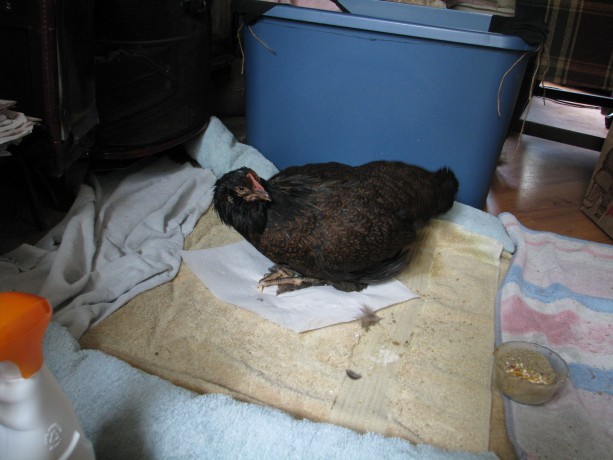
Branwyn balancing herself on her weak forelegs. Then there is Branwyn. She’s a feisty olive-egger. A few weeks ago Miranda noticed that Branwyn’s legs were bowing out as she walked. By the time she brought the bird up to the house she was paralyzed in both legs. Our immediate fear was Merek’s disease, which is highly communicable and would have meant death for all our birds, sterilization of the coop and no hens for six months or more. Within days Branwyn showed signs of moving her left leg. Miranda configured a Rubbermaid container as a bouncy chair, tying a t-shirt across it and cutting leg holes through it so Branwyn could rest with legs down and feet touching the bottom. Later, Miranda cut the legs from an old pair of tights and stuck Branwyn through to bounce her across the floor, giving her physical therapy. Sounds nutso, I know, but its working. Branwyn’s left leg is much stronger and she’s beginning to force her right leg to work. She can’t stand, but she can now get her feet under her. We still don’t know what was wrong with her; some kind of neurological disorder or possibly vitamin deficiency. We were giving her Vitamin E and B complex with selenium heavily for a week and saw her initial improvement. Vitamin deficiency can be inherited; common chicken feed should have enough in it, especially when combined with vitamins in their water.
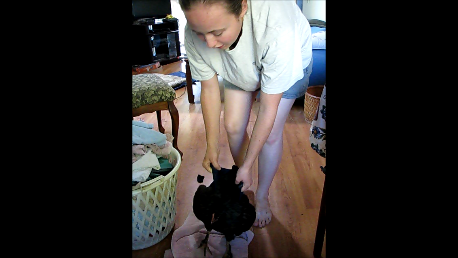
Miranda walking Branwyn in her sling made of old tights (to the tune of Surrey With The Fringe On Top). Lark, who was huge with sterile peritonitis, was drained by the vet and is several pounds lighter and much happier. She’s with the rest of the flock. Since we have no idea what caused the condition (she’s barren), it might happen again but for now she’s back kicking fruit around with the rest.
I still don’t want to participate in the hatchery butchery and torture. Anything mass-produced, be it animals, food, plants or products, are rooted in cruelty: sweat shops in other countries, underpaid workers, poor root stock, diseased, malnourished and maltreated animals, unhealthy chemical-laden food. I’m holding off on purchasing any new hens, even though I wanted a lavender Americauna. I still think that buying local, while more expensive, is better. For whatever reasons this batch have all been ill. In fact, the only hens we’re treating right now are all four of the new girls!
Chickens have wonderful personalities and make great pets, and they are pets; having a few hens for eggs and meat sounds easy but just like any living thing they require work. Especially OUR hens, who must know we won’t cull them and have decided that we are an early retirement home with personal nursing care. I wish I could look forward to such a deal!
- Animals, Bees, Birding, Books, Building and Landscaping, Chickens, Cob, Compost, Composting toilet, Fungus and Mushrooms, Gardening adventures, Heirloom Plants, Hugelkultur, Humor, Living structures, Natives, Natural cleaners, Other Insects, Permaculture and Edible Forest Gardening Adventures, Ponds, Predators, Quail, Rain Catching, Recycling and Repurposing, Reptiles and Amphibians, Seeds, Soil, Water Saving, Worms
Permaculture Lectures At Finch Frolic Garden, June 2014
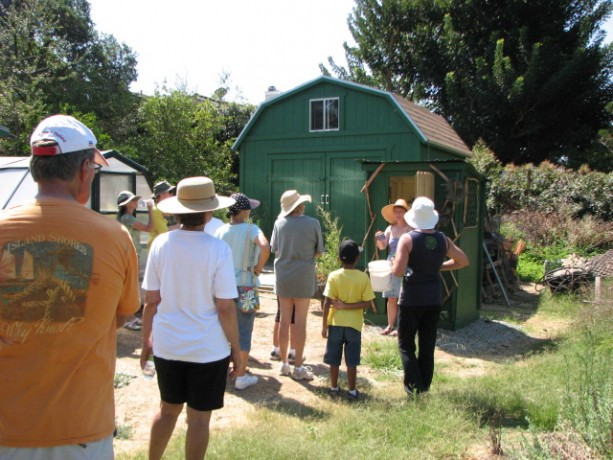
Tour Finch Frolic Garden! Permaculture Lectures in the Garden!
Learn how to work with nature and save money too
Finch Frolic Garden and Hatch Aquatics will present four fantastic, information-filled lectures in June. Join us at beautiful Finch Frolic Garden in Fallbrook, 4 pm to 6 pm, for refreshments and talks on…
Saturday, June 7: Introduction to Permaculture and Finch Frolic Tour: We’ll take you through the main precepts of permaculture and how it can be applied not only to your garden, but to yourself and your community. Then we’ll tour Finch Frolic Garden and show rain catchments, swales, plant guilds, polyculture, living buildings and so much more.
Saturday, June 14: Your Workers in the Soil and Earthworks: Learn the best methods for storing water in the soil and how to replace all your chemicals with actively aerated compost tea and compost.
Saturday, June 21: Aquaculture: You can have a natural pond – even in a tub! How natural ponds work, which plants clean water and which are good to eat. Even if you don’t want a pond, you’ll learn exciting information about bioremediation and riparian habitat.
Saturday, June 28: Wildlife in your Garden: What are all those bugs and critters and what they are doing in your yard? We’ll discuss how to live with wildlife and the best ways to attract beneficial species.
Your hosts and lecturers will be
Jacob Hatch Owner of Hatch Aquatics. With years of installing and maintaining natural ponds and waterways, and a Permaculture Design Course graduate, Jacob has installed earthworks with some of the biggest names in permaculture.
Miranda Kennedy OSU graduate of Wildlife Conservation and wildlife consultant, Miranda photographs and identifies flora and fauna and maps their roles in backyard ecosystems.
Diane Kennedy Owner of Finch Frolic Garden, lecturer, consultant, Permaculture Design Course graduate, former SDC Senior Park Ranger, Diane educates homeowners on how to save money and the environment while building their dream gardens.
Each class limit is 50 attendees, so please make pre-paid reservations soon before they fill up. Fee for set of four lectures and tour is $45 per person. Single session fee is $20 per person. Contact Diane Kennedy at dianeckennedy@prodigy.net for reservations and directions.
You will not want to miss this fascinating and useful information!
